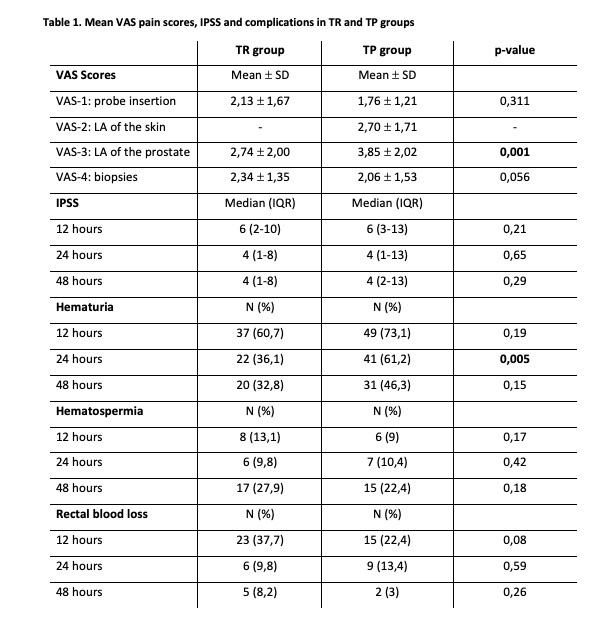Back
Poster, Podium & Video Sessions
Moderated Poster
MP53: Prostate Cancer: Detection & Screening V
MP53-14: Feasibility of transperineal prostate biopsies under local anesthesia: a comparative study with the transrectal approach
Monday, May 16, 2022
7:00 AM – 8:15 AM
Location: Room 225
Camille Berquin*, Dries Develtere, Hannah Van Puyvelde, Elisabeth Pauwels, Ruben De Groote, Frederiek D'Hondt, Peter Schatteman, Alex Mottrie, Geert De Naeyer, Aalst , Belgium

Camille Berquin
Ghent University
Poster Presenter(s)
Introduction: There is an emerging shift from transrectal (TR) to transperineal (TP) prostate biopsies because of lower infection rates. In the past TP biopsies mostly involved general/spinal anesthesia, being perceived too painful for local anesthesia (LA). Therefor the aim of this study is to evaluate the feasibility of TP prostate biopsies under LA based on patient-reported outcome measurements (PROMs).
Methods: This study is a monocentric prospective observational cohort study with a non-inferiority design. Data were collected from all patients with a clinical suspicion of prostate cancer, eligible for LA, at the OLV Aalst Urology Department. The biopsy method was determined by the clinician based on the localization and volume of the suspect lesions on MRI and DRE.
All patients received prophylactic fluoroquinolones. For the TP approach we used 30 mL of 1% Xylocai¨ne to obtain LA: 10 mL for the perineal skin and 20 mL for the periprostatic nerve block (PNB). Systemic biopsies and targeted biopsies were taken. In the TR group PNB of 10 mL was given for a classical template with 12 biopsy cores.
To evaluate tolerability, we used a visual analog score (VAS) for pain during the different steps of the procedure: insertion of the TR probe, LA to the prostate and the biopsies. The TP group had an additional VAS score for the LA of the skin. IPSS was recorded at different times: baseline, after 12, 24 and 48 hours. At these times patients also received questionnaires about possible complications of the procedure (hematuria, hematospermia, rectal blood loss and fever).
Results: In total 128 patients got enrolled: 61 TR and 67 TP. The median age was 73y (IQR 66-78,5) and 68y (IQR 64-73) for the TR and TP group respectively. The median baseline IPSS were 6 (IQR 2,5-11) for the TP group and 7 (IQR 3-13) for the TP group.
The mean VAS scores, IPSS and complications are listed per group in Table 1.
Fever occurred in 2 patients (3,3%) in the TR group, while only in 1 patient (1,5%) in the TP group. All 3 were treated with oral antibiotics. Only 1 patient in the TP group (1,5%) suffered from urinary retention, for which he received a suprapubic catheter.
Conclusions: Based on PROMs, we can conclude that TP biopsies under LA can be performed with similar pain scores and complications rates as TR biopsies.
Source of Funding: None

Methods: This study is a monocentric prospective observational cohort study with a non-inferiority design. Data were collected from all patients with a clinical suspicion of prostate cancer, eligible for LA, at the OLV Aalst Urology Department. The biopsy method was determined by the clinician based on the localization and volume of the suspect lesions on MRI and DRE.
All patients received prophylactic fluoroquinolones. For the TP approach we used 30 mL of 1% Xylocai¨ne to obtain LA: 10 mL for the perineal skin and 20 mL for the periprostatic nerve block (PNB). Systemic biopsies and targeted biopsies were taken. In the TR group PNB of 10 mL was given for a classical template with 12 biopsy cores.
To evaluate tolerability, we used a visual analog score (VAS) for pain during the different steps of the procedure: insertion of the TR probe, LA to the prostate and the biopsies. The TP group had an additional VAS score for the LA of the skin. IPSS was recorded at different times: baseline, after 12, 24 and 48 hours. At these times patients also received questionnaires about possible complications of the procedure (hematuria, hematospermia, rectal blood loss and fever).
Results: In total 128 patients got enrolled: 61 TR and 67 TP. The median age was 73y (IQR 66-78,5) and 68y (IQR 64-73) for the TR and TP group respectively. The median baseline IPSS were 6 (IQR 2,5-11) for the TP group and 7 (IQR 3-13) for the TP group.
The mean VAS scores, IPSS and complications are listed per group in Table 1.
Fever occurred in 2 patients (3,3%) in the TR group, while only in 1 patient (1,5%) in the TP group. All 3 were treated with oral antibiotics. Only 1 patient in the TP group (1,5%) suffered from urinary retention, for which he received a suprapubic catheter.
Conclusions: Based on PROMs, we can conclude that TP biopsies under LA can be performed with similar pain scores and complications rates as TR biopsies.
Source of Funding: None


.jpg)
.jpg)